
What is Japanese Techwear?
From the quickly sprawling urban fashion arena, cutting with insistent function is cutting its way up with state-of-the-art design. The cool cities of Japan are teeming and flowing with recently emerged high-profile lifestyles.
Japanese Techwear: a name that kind of evokes the idea of some futuristic clothing that weaves intricately with classical aesthetics.
This really is fusion at its finest and one that truly manages to challenge our traditionally rigid ideas about clothing, ultimately forming the very definition of where contemporary and classical style lines lie.
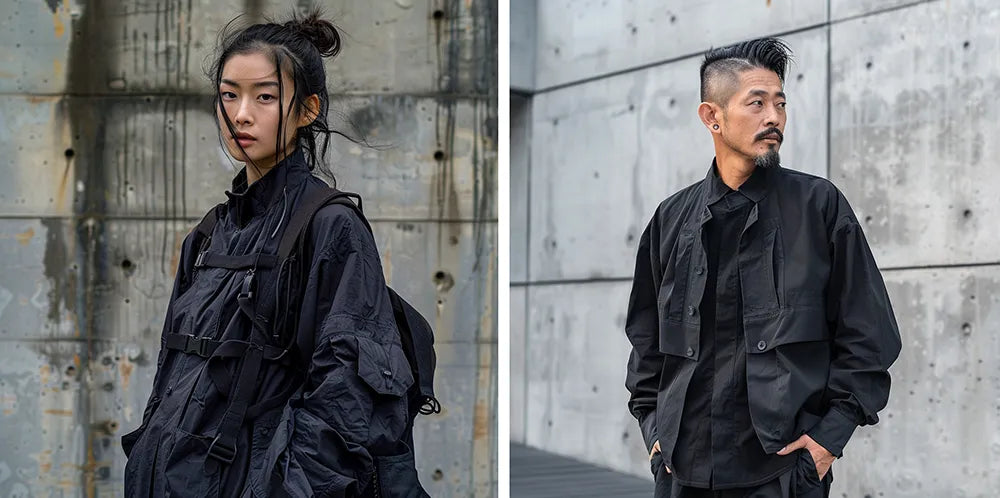
Technically, Japanese Techwear is the cutting-edge genre to combine the practical elements of techwear—from weatherproofing and comfort to utility—with the detail and aesthetics found in traditional Japanese clothing, each down to its most minute detail. The result is a style infused in profound modernity and deep heritage; offering a fresh look for what urban apparel can be.
The fact that Japanese really know so well—balancing the old with the new—how to make clothing as much for individual expressiveness as to fill the practical needs in a digitized life, shows true in this line.
If one goes deeper into the world of Japanese Techwear, he will find much more than just clothing: a real cultural phenomenon, which manages to circle the rich history of Japan and very fast development in the field of technologies and thinking out of the box.
This essay seeks to delve into the very essence of Japanese Techwear, considering the background of the origin, characteristics, and features to what degree it has affected the world. This is the journey of how Japanese Techwear became THE quintessential symbol of avant-garde functionality in urban style, and, perhaps, gives just a tiny peek into the future for where fashion itself might be going.
The Origins of Japanese Techwear

Historical Background
Tracing its roots to traditional Japanese clothing, one may be right to conclude that the country's fashion never really was at any one point about aesthetics. The development of these clothes over the centuries shows a deep collaboration between functionality and form, where each fold and choice of fabric was in service to something.
Ancient wear, be it the Kimono, Hakama, and so forth, it had been designed with flexibility and comfort in place, and at the same time, it had to cater to the life and needs of the one wearing the attire. It was essentially the basis of the idea of blending sophistication with practicality in what, in the end, became modern techwear.
It wasn't as though there was simply a switch that went off from those traditional garbs to what we have today as "techwear." It was, in a sense, kind of a flowing change, driven by the transformation of the needs of societies and the advancement of technologies that enshrined the "crazy" innovations of Japanese culture.
Birth of Japanese Techwear
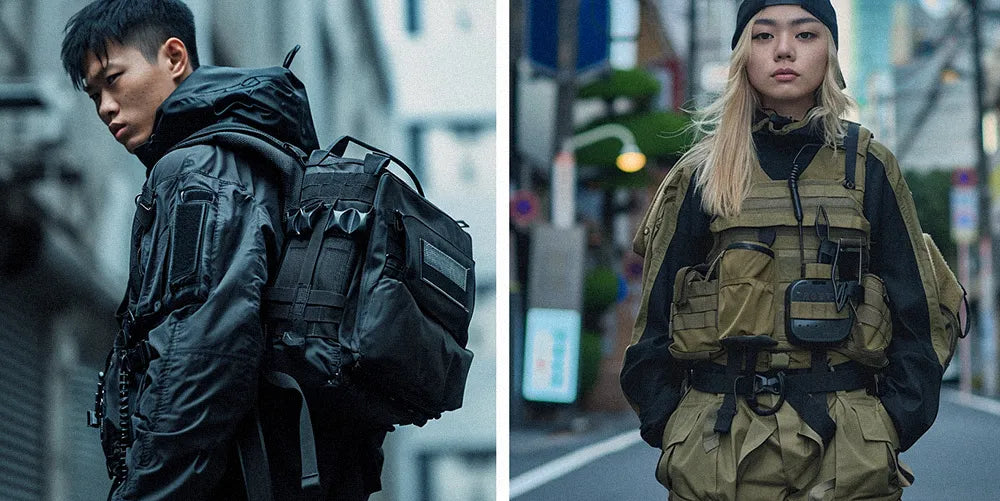
Japanese Techwear was born in modern Japan, keeping up with tendencies in technology and finding out the potential it had. When Japan started to be the leader in technology worldwide, closer to the end of the 20th century, its fashion started embracing the new identity which this country has.
Designers began playing around with new fabrics and manufacturing technologies that would evolve the traditional design of clothing to make it functional, like water resistance, breathability, and modular design. This amalgamation of technology and fashion brought about a really unique style that celebrated the cultural history of Japan at a point when it was looking to the future.
Japanese Techwear first introduced itself to the world through pioneering material use like Gore-Tex and nylon, coupled with its very own aesthetic that harmonized the ancient with the hyper-modern.
This new genre was more about making a statement on the utility and adaptability of fashion in modern times than it was about style, positioning Japanese Techwear at the vanguard of the major movements in the evolution of urban attire.
Defining Japanese Techwear
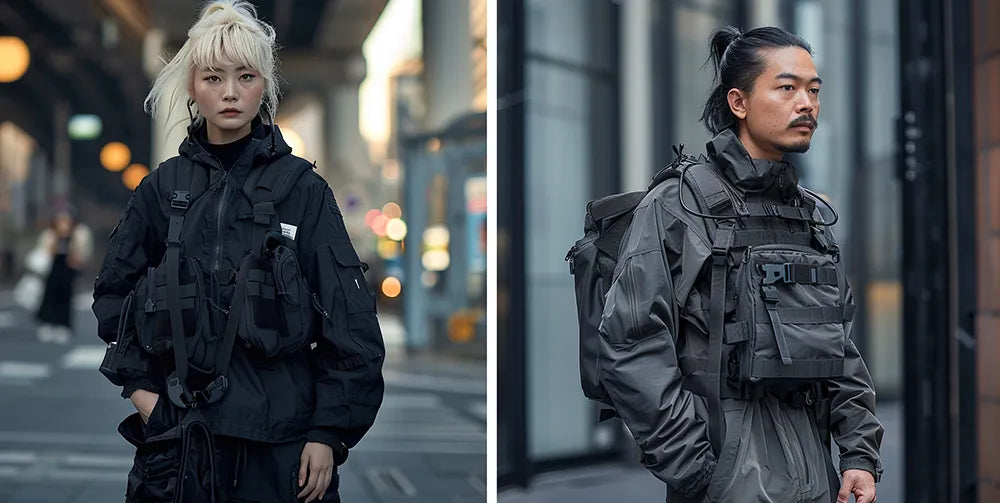
Key Characteristics
Japanese Techwear is the modern urban elite uniform, offering a perfect look with its advanced materials and combined functionality. At the core of its design philosophy is the coming together of the latest technology with pragmatic use so that each piece is as useful as its visual strength.
Think sleek, think futurist, often with asymmetry, and a palette monochromatic inspired by the cyberpunk and sci-fi image. It does echo such aesthetic qualities by use of high-performance materials, e.g., Gore-Tex, nylon, and neoprene that are highly functional to the durability of water repulsion and breathing. It is this that has been sought after.
The other strong base of Japanese Techwear is that of functionality. It comes in a modular design, with many functional pockets and adjustable straps to be functional and adaptable. All these make them highly customizable and personalized for the one wearing them to change his or her clothing for specified requirements or preferences.
Besides, Japanese Techwear aesthetic principles mostly have a minimalist ethos, reflecting simplicity and efficiency, yet still stylish. Together with these properties combined, Japanese techwear offers an unusual unison of creativity and new design vision within urban fashion.
Cultural Influences

The design and ethos of Japanese Techwear are deeply influenced by Japanese culture, art, and philosophy. The minimalist aesthetic, grounding in common Japanese Techwear, is traceable to traditional Japanese concepts such as Ma (space) and Wabi-sabi (beauty in the imperfection), which are simple, asymmetrical, and having regard to nature.
These principles in color design serve to encourage appreciation of the intrinsic beauty of material and design, affording subtlety and profundity of visual appeal in the garment. The harmony found between function and form in Japanese Techwear reflects the Japanese philosophy of Mujo.
This is underscored by the fact that garments of techwear are modular and versatile, suiting the environments they are used in and the needs. Of course, Japanese art played an important contribution through the ukiyo-e woodblock prints to the modern manga and anime in the great contribution it had made to the visual language.
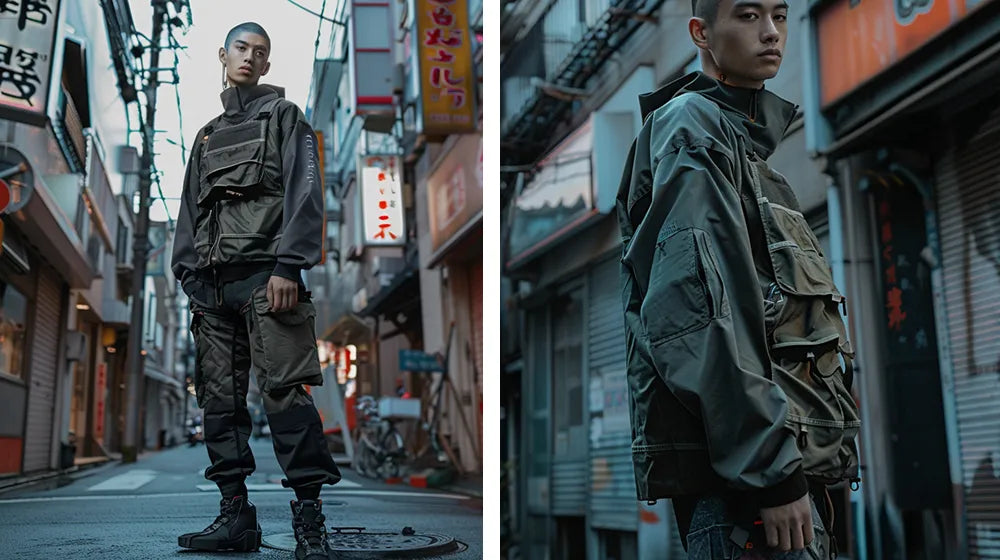
The general ideology behind these art forms is often carried out by figures in energetic, flowing costumes, influencing the fluid lines and dramatic silhouettes of techwear designs.
And when these traditional motifs and patterns are infused into the clothing of today, it is almost a gesture of respecting heritage so much that it develops into something beautiful, with a rich mixture of old and new, nostalgic yet novel.
This convergence of old and new shows respect for the past and seems to challenge what is conventional in fashion, drawing wearers to experiment with new characteristics and flirt with other personae through garmenture.
Born from an innately cultural root, Japanese Techwear extends much beyond just its function with a philosophy and aesthetic which is achingly Japanese.
The Evolution of Japanese Techwear

The evolution of the path that Japanese Techwear has taken from its conceptual birth down to the current standing as an important cornerstone within urban fashion has been quite significant along the way—not only in the philosophy of design but also in the integration with technology.
This development reflects the growing science of materials and their making approaches, but it reflects what has happened with cultural and aesthetic sensitivity in Japan and in the world.
The seeds for Japanese Techwear were sowed in the late '80s and early '90s, as designers began experimenting with technically engineered fabrics and pragmatic designs, which like their Western equivalents, were all too often borrowed from the military and outdoors playbook.
That was the first time when fashion was combined with utility, thus laying an inevitable basis for the future aesthetic of techwear. This opened up the whole new line of thinking in clothing, which offered unbeatable weather-proofing and breathability to a growing urban market of explorers and streetwear enthusiasts.
By 2000, the look was noticeably moving toward the more futuristic aesthetic, largely on account of Japan's red-hot technology scene and the still-escalating worldwide obsession with all things cyberculture.

This resulted in designers who then began mixing their creations with a bit of both cyberpunk and sci-fi, and therefore began creating more avant-garde styles. As such, even smart textiles and wearable technology came under the fold of fashion, thus blurring the fine line that was drawn between fashion and functionality.
In the recent past, there is somewhat of a movement toward sustainability and ethical manufacturing within the Japanese Techwear scene, reflecting the broader global tendency towards more accountable fashions.
Now, advanced recycling technologies and eco-friendly materials are taking the scene to show commitment to innovation for the wearers and the environment.
Throughout its evolvement, Japanese Techwear has been at the forefront of this urban fashion, apparently always trying to find where the limits of garments can possibly lie. Its history reads like a document of traditions fighting against innovation, which reflects the current face of fashion and technology, changing every few years.
Key Elements of Japanese Techwear

Design and Functionality
Key to their design in Japanese Techwear: it features groundbreaking design characteristics with unequaled functionality that clearly sets it apart from any other style amidst urban fashion.
Japanese Techwear Designers combine aesthetics with functionality, making garments not just appealing to the eye but as well really usable. Modular cut and adaptive design are also another typical characteristic of this style, whereby one can shape and redesign according to the need at that time or according to his or her liking.
Such modularity is often engendered with detachable components, expandable pockets, and adjustable straps, which increase the utility of the garment but not without making a dent in its style.

Another distinctive feature is the emphasis on ergonomics and movement. Japanese Techwear is what happens when you design clothing around the human body for both comfort and flexibility against the protection from elements.
These include articulated joints, gusseted panels, and the use of fabrics that can stretch into the movement of the body so that there could be a flawless transition from one kind of physical activity to another.
The integration of smart technology into clothing is also a significant aspect of Japanese Techwear. Clothing can be designed with built-in electronics or elements and reflective coatings with UV protection properties—everything to expand the field of use. Such a combination of technology and fashion gives utilitarian benefits along with the creation of futuristic aesthetics, which is characteristic of Japanese Techwear.
Material Innovation

The core of Japanese Techwear is functionality and design; it's material innovation. The genre derives, in essence, from new materials and fabrication techniques, allowing unbeatable durability, weather resistance, and comfort.
Essentially, Japanese Techwear usually is comprised of technical fabrics like Gore-Tex, Cordura, and neoprene, and which are ideally chosen to be able to repel water and even resist abrasion while keeping breathability intact.
These materials ensure the clothes can be resistant to the environments in urban and outside areas, giving the wearers a means of feeling reliable and protected.
In addition to these iconic textiles, the material palette of Japanese Techwear often involves newly developed textile fibers at the forefront of textile technology. Some of these include self-healing fabrics, heat-responsive materials, and sustainable textile developments like the recycling of plastics or organic compounds.
These elements contribute to the functional features of clothing but also add to growing environmental sustainability concerns within the fashion industry. Fabrication techniques play a crucial role in the effectiveness of these materials.

They also adapt innovative ways such as seam sealing, laser cutting, and 3D knitting for the purpose of precise and minimal waste construction. These styles will also sometimes enhance the functionality of the product but more likely contribute to the slick, minimalist aesthetic, characteristic of Japanese Techwear.
Japanese Techwear is the epitome of urban fashion, mainly due to its unyielding approach toward experimentation and innovation not only in design but also in material use. Its commitment to pushing the envelope of material science and garment construction has been not only the sole enforcer of new standards for techwear across the globe but also the poster child for the potential of fashion to seamlessly integrate with modern urban life.
Major Brands and Designers

More of a style, Japanese Techwear is a movement driven by some of the most visionary designers and forward-thinking brands on the globe. They have set the trend for this genre and have been copied around the world in urban fashion.
ACRONYM
Founded by Errolson Hugh and Michaela Sachenbacher, ACRONYM stands at the top of Japanese Techwear, though it is often called more international than others because it has many different influences. ACRONYM is highly appreciated for extremely functional design, innovative materials, and modular attachments.
Their design philosophy of "form follows function" was observed with every piece very carefully designed to offer the user utility and aesthetic appeal in the most unmatched way.
That said, their flagship collection, J1A-GT, went on to become a hallmark in the techwear community for its distinctive sleek and functioned Gore-Tex fabric design.
Y-3
Y-3—one of the greatest brand partnerships—merges complex craftsmanship and game-changing design, all with the avant-garde attitude of Yamamoto. Y-3 styles sportswear in a high-contrast palette full of fun, and in signature oversized silhouettes, thanks to Yamamoto.
The guiding approach of the brand would be that of fluidity and movement in techwear. There should be some of the most elastic fabrics within their collections and only keeping back some minimalism for the design.
The Qasa High sneaker sums up the kind of innovation seen in Y-3's techwear footwear with its distinct rolled-ball sole and overall neoprene body.
TECHWEAR STORM
TECHWEAR STORM™ is more than a brand; it's an urban wear revolution. Being a flagship of the techwear movement, TECHWEAR STORM™ sets the standards for others, driven by nothing less than the vision for a world in which clothes are the ultimate expression of technology and style.
The brand aims to dress forward-thinking, urban explorers, and digital warriors with gear as tough and dynamic as they are. Fashion with the firm commitment to innovation, sustainability, and community threaded into every piece of existence. Pushing the boundary of what fashion can be.
Issey Miyake
Issey Miyake is a great one, and he has put enormous contributions into the Japanese Techwear scene with pleating techniques and combinations of experimental fabrics.
His brand philosophy is based on the relationship with the body and fabric, where clothing is sculpturally developed with functionality in mind. Of particular interest would be the Pleats Please line: style folded in with comfort and ease of care in a manner decidedly functional to techwear. Miyake has always transcended the material used in his designs, which sets him up as a techwear icon.
White Mountaineering
Conceived by Yosuke Aizawa, White Mountaineering combines high-performance for the great outdoors with urban aesthetics. Praised for details, technical fabrics, and functionality fused into one seam under streetwear designs. In effect, most of the collection from White Mountaineering is an all-weather collection, very wearable and adapts considerably well from urban wear to outdoor wear.
This special attention by the brand to its garments is what has sealed its name within not only the techwear and streetwear circles but also within its collaboration with Adidas.
Final Home
Final Home is a brand of techwear label that fits perfectly in the survivalist angle that many people attach to this style of dressing, largely based on the brand's marketing.
Designed by the talented designer Kosuke Tsumura, Final Home aims to achieve preparedness and adaptability with its line of clothes that offer comfort and function in a range of clothes designed for extreme conditions. The brand became infamous with its 24-pocket jacket, where the user could keep everything on themselves for any event.
Final Home treats the idea by encouraging the notion of a garment to view the garment as something he cannot live without in order to survive in this world.
NORAGI by Visvim
Visvim was created by Hiroki Nakamura; he succeeded in combining traditional Japanese craftsmanship with the newest vision in design and technologies. No wonder its NORAGI line, inspired by classic Japanese farmers' workwear, very much reflects Nakamura's undying commitment to heritage and quality.
The clothes will feature hand-sewn details, natural dyes, and organic materials—a sort of luxury, reverence for Japan's artisanal traditions.
From the very best within Japanese Techwear, these are designers and labels which bring forth the highest quality and caliber to a genre that holds far more perspectives, innovations, and functionality than can ever be counted.
Their work goes on to define not only the parameters of what techwear can be but also sets the standard for a world community that shares these values in the fusion of technology, functionality, and style.
Styling Japanese Techwear
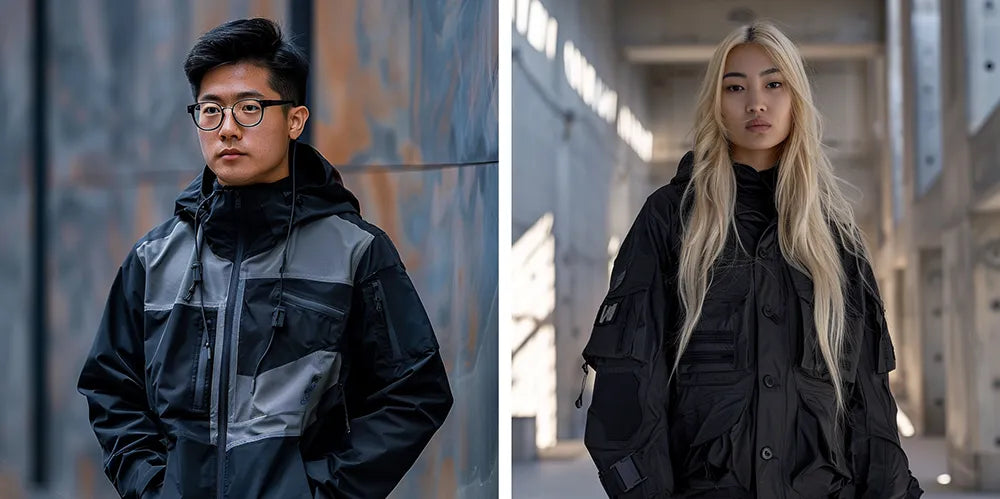
And with Japanese Techwear added to the mix of daily wardrobes, it offers an open opportunity to blend sharp functionality with distinctive aesthetics, offering up an edgy look that is always innovative and stylish.
Below are some practical tips for those willing to tap into the world of Japanese Techwear more and integrate its elements seamlessly to create a unique and cohesive look.
Start with the Basics
Start off by investing in a few key pieces that epitomize Japanese Techwear: water-resistant jackets, cargo pants with multiple pockets, and technical sneakers to name but a few. These foundational pieces will form the building blocks of your techwear outfit and offer versatility with options to pair up with other pieces from your wardrobe.
Layering for Function and Style

Layering is one of the most important parts of Japanese Techwear. It adds not only the aesthetic value, but functions as well, of course. Start with the lightweight base layer, such as the technical tee or the compression top, then add layers depending on both the weather and style of an individual.
You can also consider a utility-pocketed vest or a sleek modular backpack that brings in more functionality. Layering will help you acclimatize to the temperature changes and also give your outfit dimension.
Incorporating Traditional Elements
If you try to find a way to somehow integrate a few traditional Japanese design details within your techwear look, then something inspired by classical clothing like a Noragi or Kimono will work wonders.
Layer these items on top of some more modern techwear pieces to give some contrast in texture and style, similar to Japan's rich cultural heritage. Clothing with some subtle, traditional print or textile will help bring a sense of visual interest into your outfit as well.
Focusing on Monochromatic and Neutral Palettes

Japanese Techwear tends to use monochrome or neutral color palettes that bode very well with the tastes of minimalistic aesthetics and are best to be used for interchangeability. Choose blacks, grays, and earth tones to keep everything cohesive, allowing the textures and silhouettes of the outfit to shine without overwhelming the eyes.
Accessorizing Wisely
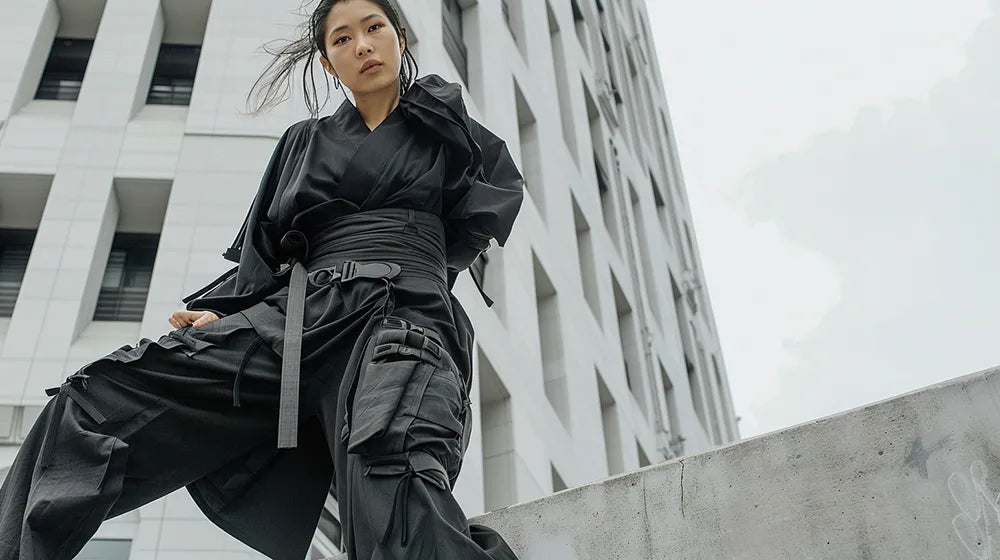
Accessories can take this basic techwear outfit and turn it into something very special. Include extra accessories, such as sling bags, utility belts, and gadget pouches, which add value and utility to your outfit. Choose pieces that complement the rest of your attire in both color and style, ensuring a harmonious look.
Herewith, including the above-enumerated styling tips, fans of Japanese Techwear can harmoniously unite both traditional and futuristic components of Japanese Techwear while actually making the outfit functional, comfortable, yet distinctively expressive and even visually interesting.
The Global Impact of Japanese Techwear
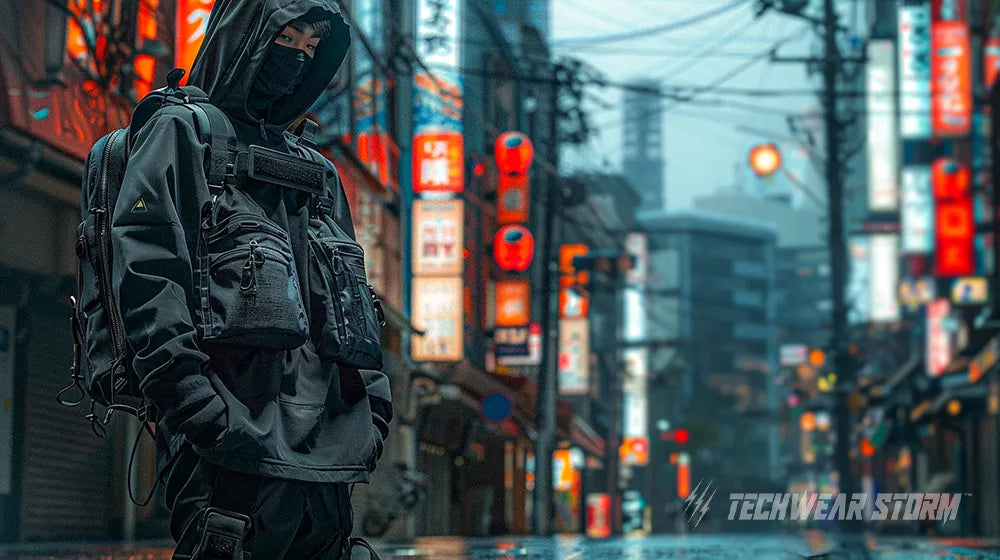
The influence of Japanese Techwear over the world fashion scene is one of immense influence and far-reaching magnitude that marks itself within the reshaping of perceptions of urban and functional wear across the globe.
This very style that was inventive in material, precision of detail, and fusion of traditional beauty with the functionality for the future became an obsession of designers and fashionistas who took it and adapted it to as many parts of the world as one can imagine.
Pioneering a New Aesthetic
Japanese Techwear takes the cake as the originator of this aesthetic, signaling a focus from a new age on function, minimalism, versatility, and technical integration.
The themes have inspired a lot of international brands and designers to take a cue or re-tap from them, making them create clothing where style is put on the pedestal but also its utility and adaptability to the wearer's lifestyle.
The world certainly took notice of the unique feel and look of Japanese Techwear, which has found its way into the mainstream with their sleek silhouettes and technology in their fabrics.
Collaboration and Influence
Much globalized, of course, following from such strong symbiosis has been the cross-pollination of ideas and talent between most innovative designers in Japan and the global set of international brands. It was collaborations like these, from an iconic Japanese Techwear brand with Western fashion houses, that brought the unique ethos of Techwear to an ever-larger audience.
With the Eastern and Western design philosophies combining, it was high time the fashion landscape got something genuinely global and inclusive.
This collaboration has not only enriched the drape of fashion in the world but also has brought very sharp appreciation for the stylized practicality and inventiveness of Japanese Techwear.
Cultural Exchange Through Fashion

Not only that, Japanese Techwear has really opened cultural doors by style, encouraging other walks of life to take a look at aspects of Japanese culture for use in their personal styling.
This has gone on to build an extended community of Techwear fans who value the genre for the arts and value of its culture and the history it speaks of through design.
From its birth to today, Japanese Techwear constantly continues its evolution and inspires with its global influence. This not only puts the conventional concept of functional clothing into question but also sets and makes new standards for how fashion can combine seamlessly with technology, lifestyle, and culture.
Reaching its infinitive reach, Japanese Techwear has become much more than a fashion trend: it is an unbound movement for design, innovation, and cultural exchange.
Conclusion: The Future of Japanese Techwear

One can trace Japanese Techwear from a niche to a notable progress with words; it speaks volumes of their enduring appeal and pioneering spirit in the worlds of urban fashion.
Japanese Techwear leads in how the form can meet the function in dressing, with a blend of leading high-tech materials and designs, combined with sophisticated cultural aesthetic principles from Japan.
This special combination has set new standards in the field of functional clothing and has spurred a global debate on the future of fashion itself.
Looking ahead, the potential directions for Japanese Techwear are as boundless as the technology that fuels it. Integrating wearable technology and even having smart fabrics capable of changing color, thermoregulation, or surfing the web could suggest a future with clothes that are even more integral to our digital life than just for style or protection.

Furthermore, as sustainability continues to be of growing importance, Japanese Techwear is on course to be at the helm through its groundbreaking innovations in recycled materials and eco-friendly production techniques.
They are making a move to recode fashion for more responsible and sustainable practice. Combining tradition with innovation—to some extent, it is true that this ethos of Japanese Techwear reflects a broader tendency in urban fashion toward apparel that finds respect for the past while vaulting into some futuristic realm.
In doing so, not only is the design process enriched, but the wearer is afforded a deeper experience with their own clothing, each piece telling a story of cultural heritage meshed with innovation.
Further adapting the changes to Japanese Techwear of today, this avant-garde direction is going to reach much further into the future of urban fashion and encourage designers, brands, and wearers to think outside the box with the role clothing has within our daily lives.
The future of Japanese Techwear is no longer just new material or new technology; it becomes the new development in making a vision of fashion where utility, beauty, and culture will live together harmoniously and cross into each other to direct us towards more thoughtfully and innovative dressing ways for the world of tomorrow.




Leave a comment
This site is protected by hCaptcha and the hCaptcha Privacy Policy and Terms of Service apply.